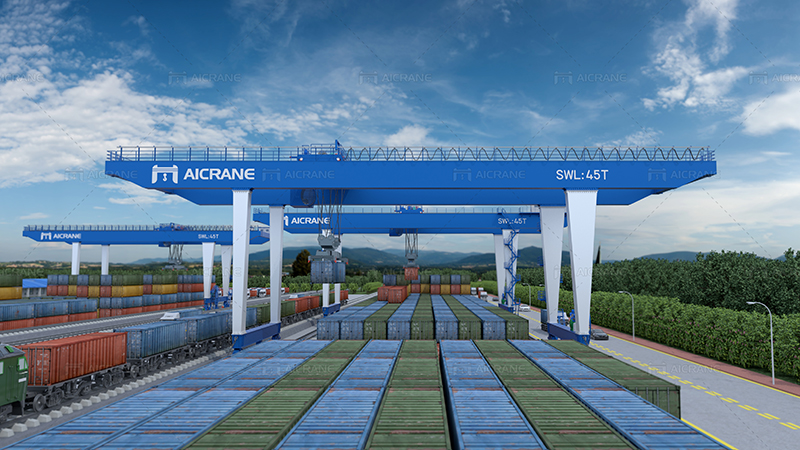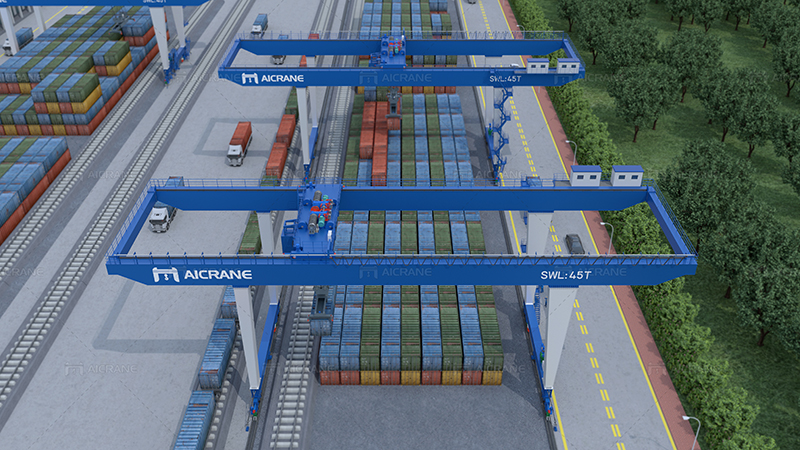Rail-mounted container gantry cranes, or RMG cranes, are vital equipment in the world of logistics and port operations. These colossal machines are responsible for the efficient handling of shipping containers in busy container terminals, enabling the seamless transfer of goods from ships to storage areas and vice versa. One of the critical aspects of RMG crane operation is the power source that drives these massive structures. In this article, we’ll delve into how RMG container gantry cranes are powered, exploring the systems that keep them moving and functioning with precision.

The Basics of RMG Container Gantry Cranes
Before we dive into the intricacies of power systems, let’s begin with an overview of RMG container handling gantry cranes. These cranes are mounted on rails or tracks, allowing them to traverse the length of a container yard with remarkable speed and accuracy. RMG cranes play a pivotal role in loading and unloading containers from ships, stacking them in rows and tiers within the terminal, and relocating them as needed.
The gantry structure of an RMG crane is the core feature, comprising robust steel beams that provide support and house the machinery required for container handling. The cranes are typically equipped with a spreader, the lifting mechanism used to grasp and hoist containers. The spreader is adjustable and can be tailored to various container sizes, contributing to the crane’s versatility.
How Are Container Gantry Cranes Powered?
Now, let’s explore the methods by which RMG container gantry cranes are powered to perform their essential tasks.
Electrical Power
One of the most common power sources for RMG container gantry cranes is electricity. These cranes are typically connected to an external power source, and the electricity powers various components, including the gantry’s motors and control systems. Here’s how electrical power drives the operation of RMG cranes:
Motors: Electric motors are responsible for moving the crane along the rails, operating the hoisting machinery, and controlling other essential functions. These motors ensure precise and efficient movements.
Control Systems: The electrical power source also energizes the control systems within the crane’s operator cabin. Operators use these systems to control the crane’s movements, such as lifting, lowering, horizontal travel, and precise positioning.
Safety Features: Electricity powers the crane’s safety features, including emergency stop mechanisms and collision avoidance systems, ensuring the safety of operations.
Lighting and Communication: Lighting on the crane structure and communication systems are also powered by electricity, enabling visibility and coordination during operations.
Hybrid Power Systems
In some cases, RMG cranes utilize hybrid power systems that combine electricity with other power sources to enhance energy efficiency and reduce environmental impact. These hybrid systems are increasingly popular in an era of heightened focus on sustainability and reduced carbon emissions. Here’s how hybrid power systems work:
Electricity: The primary source of power in a hybrid system is still electricity, providing the necessary energy to operate the crane’s motors and control systems.
Energy Storage: Hybrid systems often incorporate energy storage solutions, such as batteries or supercapacitors, which store excess electrical energy generated during crane operation. This stored energy can be used during peak demand periods, reducing energy costs.

Regenerative Braking: RMG cranes equipped with hybrid systems may feature regenerative braking. When the crane lowers a load, it generates energy that is converted and stored for future use, further optimizing energy consumption.
Auxiliary Power: In some cases, RMG cranes with hybrid systems use auxiliary power sources, such as natural gas generators or hydrogen fuel cells, to supplement electrical power. These sources can help reduce emissions and dependency on conventional fossil fuels.
Diesel-Electric Power
In situations where a dedicated electrical power supply is not readily available, RMG cranes may rely on diesel-electric power systems. These systems combine a diesel engine with an electric generator to provide the necessary power. Here’s how diesel-electric power systems function:
Diesel Engine: The diesel engine serves as the primary power source, driving an electric generator that produces electricity. This electricity is then used to operate the crane’s motors, control systems, and other components.
Portability: Diesel-electric RMG cranes are often used in locations where a permanent electrical connection is not feasible, such as remote ports or during temporary construction projects. Their portability allows them to be deployed where needed.
Emissions Control: To address environmental concerns, modern diesel-electric RMG cranes may incorporate emission control technologies, such as exhaust gas treatment systems, to minimize air pollution.
Alternative Power Sources
As the world transitions towards more sustainable energy solutions, RMG crane manufacturers are exploring alternative power sources, such as solar and wind. While these sources are not yet the primary power solutions for most RMG cranes, they hold promise for the future. Here’s how alternative power sources can be integrated into RMG crane systems:
Solar Power: Solar panels can be installed on the crane’s structure to capture energy from the sun. This energy can then be converted into electricity to power various crane components. Solar power can be particularly effective in regions with ample sunlight.
Wind Power: Similarly, wind turbines can be integrated into the crane structure to harness wind energy, which can be converted into electrical power. This approach is more suitable for locations with consistent and strong winds.
Energy Storage: Both solar and wind power systems may incorporate energy storage solutions to ensure a consistent power supply, even during periods of low sunlight or wind.
Conclusion
RMG container gantry cranes are the workhorses of the logistics and shipping industry, enabling the efficient transfer of goods in and out of container terminals worldwide. The choice of power source for these massive machines depends on factors such as the availability of electrical infrastructure, environmental concerns, and port-specific requirements. Electricity remains the primary power source for most gantry cranes, providing the energy needed to operate motors, control systems, safety features, and auxiliary components. Hybrid power systems are gaining traction, offering improved energy efficiency and reduced emissions. Diesel-electric power is a practical solution for locations where a stable electrical connection is unavailable.
In the future, alternative power sources like solar and wind may play a more prominent role as the industry continues to prioritize sustainability and reduced environmental impact. Regardless of the power source, RMG container gantry cranes are indispensable in keeping the global supply chain running smoothly and efficiently.